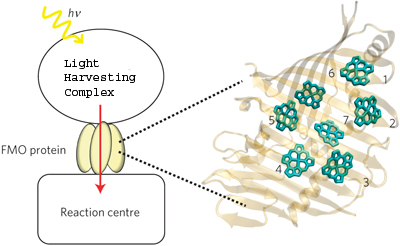Quantum entanglement in a real biological system found
May 11, 2010
Scientists at Lawrence Berkeley National Laboratory and UC Berkeley have made the first observations of quantum entanglement in a real biological system.
The results of this study hold implications for the development of artificial photosynthesis systems as a renewable non-polluting source of electrical energy, and for the future development of quantum-based technologies in areas such as computing.
Contrary to the popular scientific notion that entanglement is a fragile and exotic property, difficult to engineer and maintain, the Berkeley researchers have demonstrated that entanglement can exist and persist in the chaotic chemical complexity of a biological system over picosecond timescales and relatively immune to the effects of increased temperature.
“We present strong evidence for quantum entanglement in noisy non-equilibrium systems at high temperatures by determining the timescales and temperatures for which entanglement is observable in a protein structure that is central to photosynthesis in certain bacteria,” says says Mohan Sarovar, a post-doctoral researcher at the Berkeley Center for Quantum Information and Computation.
Previous experiments pointed to quantum mechanical effects as the key to the ability of green plants, through photosynthesis, to almost instantaneously transfer solar energy from molecules in light harvesting complexes to molecules in electrochemical reaction centers.
The new research has identified entanglement as a natural feature of these quantum effects. When two quantum-sized particles, for example a pair of electrons, are “entangled,” any change to one will be instantly reflected in the other, no matter how far apart they might be. Though physically separated, the two particles act as a single entity.
“This is the first study to show that entanglement, perhaps the most distinctive property of quantum mechanical systems, is present across an entire light harvesting complex,” says Mohan Sarovar.
The results of this study hold implications for the development of artificial photosynthesis systems as a renewable non-polluting source of electrical energy, and for the future development of quantum-based technologies in areas such as computing.
This research was supported in part by U.S. Department of Energy’s Office of Science, and in part by a grant from the Defense Advanced Research Projects Agency (DARPA).

The schematic on the left shows the absorption of light by a light harvesting complex and the transport of the resulting excitation energy to the reaction center through the FMO protein. On the right is a monomer of the FMO protein, showing its orientation relative to the antenna and the reaction center. The numbers label FMO's seven pigment molecules. (Mohan Sarovar)
More info: Berkeley Lab news